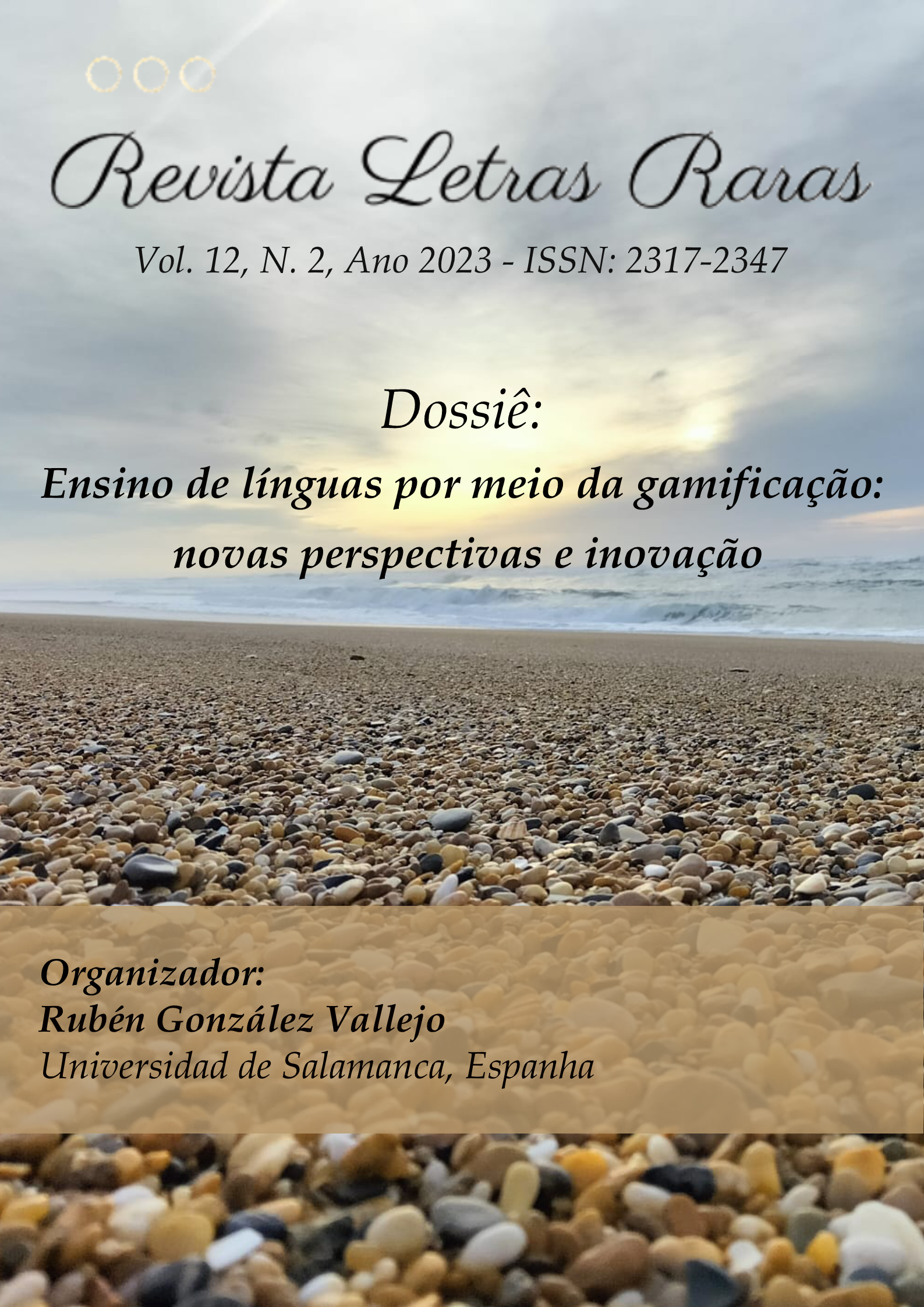Game-based teaching and gamification in ELE: cases and projects
DOI:
https://doi.org/10.5281/zenodo.8301638Palavras-chave:
Game, Gamification, Spanish as a Foreign Language, MotivationResumo
The present work deals with the game and the strategy resulting from the use of its elements, also known as gamification, as motors of the motivation of students of Spanish as a foreign language. Starting from the relevance of the game in the learning process from positions ranging from the anthropological to the neuroscientific, the ideas of the narrative component and the sensation of the game are addressed as prominent elements in this objective of involving students in learning tasks, providing specific practical cases on its application.
Downloads
Referências
ACASO, M. Pedagogías invisibles. Madrid: La Catarata, 2011.
ACASO, M. Reduvolution. Hacer la revolución en la educación. Barcelona: Paidós, 2013.
ANDRADE-VELÁSQUEZ, M. R., & FONSECA-MORA, M. C. Las narrativas transmedia en el aprendizaje de lenguas extranjeras. Revista Mediterránea de Comunicación, v.12, n.2, p. 159-175, 2021.
ARNOLD, J. & FONCUBIERTA, J. M. La atención a los factores afectivos en la enseñanza del español como lengua extranjera. Madrid: Edinumen, 2019.
ASHER, J. J. Imagination in second language acquisition. The Journal of Imagination in Language Learning, v.1, pp. 20-25, 1993.
BLAKE, R. J. Homo ludens, los vídeojuegos y las TIC. En Actas del IV congreso de FIAPE: La enseñanza del español en un mundo intercultural. Jornadas pedagógicas, Santiago de Campostela, España, 2011. Disponible en: http://www.anpenorge.no/fiape/IVcongreso/actas.html
BOUDADI, N. A. & GUTIÉRREZ-COLÓN, M. Effect of Gamification on students’ motivation and learning achievement in Second Language Acquisition within higher education: a literature review 2011-2019. The EuroCALL Review, v.28, n.1, p. 57-69, 2020.
BRUNER, J. Actos de significado. Más allá de la revolución cognitiva. Madrid: Alianza Editorial, 2000.
CSIKSZENTMIHALYI, M. & SELIGMAN, M. E. Positive psychology: An introduction. Flow and the Foundations of Positive Psychology: The Collected Works of Mihaly Csikszentmihalyi, p. 279-298, 2014.
CONSEJO DE EUROPA. Marco Común Europeo de Referencia para las Lenguas. Madrid: Anaya e Instituto Cervantes, 2002. Disponible en: http://cvc.cervantes.es/obref/marco/
DÍAZ-BRAVO, R. Guadalingo: aprendizaje experiencial de español LE/L2 en un entorno virtual gamificado. Journal of Spanish Language Teaching, v.6, n.1, p. 64-70, 2019. DOI: 10.1080/23247797.2019.1613078
FONCUBIERTA, J.M., & RODRÍGUEZ SANTOS, J. M. Didáctica de la gamificación en la clase de español. Madrid: Edinumen, 1-8, 2014. Disponible en: https://espanolparainmigrantes.files.wordpress.com/2016/04/didactica_gamificacion_ele.pdf
FONCUBIERTA, J. M. & RODRÍGUEZ SANTOS, J. M. Metáforas, símbolos y comunicación en el aula de ELE. Mosaico, v.34, p. 22-28, 2016. Disponible en: http://www.mecd.gob.es/belgica/publicaciones-materiales/publicaciones.html
GROS, B. Videojuegos y aprendizaje. Barcelona: Editorial Graó, 2007.
HUIZINGA, J. Homo Ludens. A study of the play-element in culture. London: Routledge y Kegan Paul, 1949.
INSTITUTO CERVANTES. Plan Curricular del Instituto Cervantes. Niveles de referencia para el español. Madrid: Instituto Cervantes, 2006. Consultado el 18 de noviembre de 2022. Disponible en:http://cvc.cervantes.es/Ensenanza/biblioteca_ele/plan_curricular/default.htm.
LABRADOR PIQUER, M. J. & Morote Magán, P. El juego en la enseñanza de ELE. Glosas Didácticas, v.17, p. 71-84, 2008. Recuperado a partir de http://www.um.es/glosasdidacticas/numeros/ GD17/07.pdf
LORENTE-FERNÁNDEZ, P. & PIZARRO-CARMONA, M. El juego en la enseñanza de español como lengua extranjera: Nuevas perspectivas. Tonos Digital: Revista de estudios filológicos, v.23, 2012. Recuperado de http://www.um.es/tonosdigital/znum23/secciones/estudios-14-_el_juego.htm
MARTÍN, P. P. La aplicación de la ludificación y las TIC a la enseñanza de español en un contexto universitario japonés. Cuadernos Canela, v.25, p. 65-83, 2014.
Mora, F. Neuroeducación. Solo se puede aprender aquello que se ama. Madrid: Alianza Editorial, 2017.
NEVADO, C. El componente lúdico en las clases de ELE. MarcoELE, 7, 2008. Recuperado el 22 de noviembre de 2022. Disponible en: http://marcoele.com/descargas/7/nevado_juego.pdf
REINHARDT, J. (2019). Gameful second and foreign language teaching and learning: Theory, research, and practice. Tucson: Palgrave Macmillan, 2019.
RODARI, G. Gramática de la fantasía: Introducción al arte de contar historias. 8ª edición. Barcelona: Ediciones del Bronce, 2002.
Stevick, E. Alienation as a Factor in the Learning of Foreign Language. En The Annual Meeting of the American Council on the Teaching of Foreign Languages, Washington, D.C., Nov. 1975, p. 27-30. Disponible en: http://files.eric.ed.gov/fulltext/ED113979.pdf
Downloads
Publicado
Como Citar
Edição
Seção
Licença
Copyright (c) 2023 Revista Letras Raras

Este trabalho está licenciado sob uma licença Creative Commons Attribution-NonCommercial 4.0 International License.







